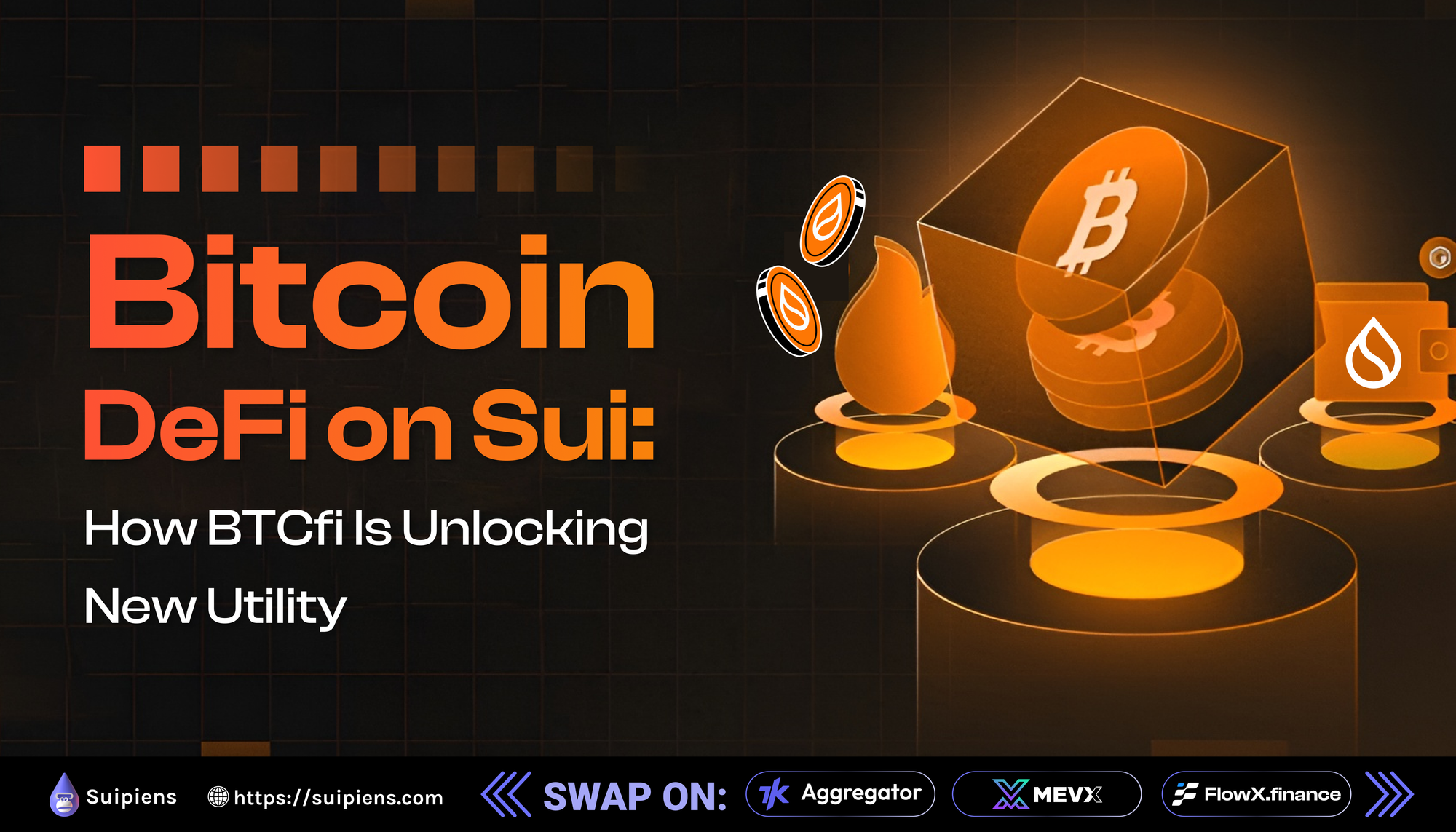Bitcoin DeFi on Sui: How BTCfi Is Unlocking New Utility

BTC holders can now access DeFi on Sui through wBTC, LBTC, and sBTC—bringing real yield and utility without compromising decentralization.
Bitcoin DeFi (BTCfi) Finds New Ground on Sui Network
Despite being the most decentralized and secure digital asset, Bitcoin has long struggled with limited utility. Its role as a store of value is undisputed, but technical constraints have historically kept it out of the growing decentralized finance (DeFi) landscape. That’s changing—fast.
Enter BTCfi, short for Bitcoin DeFi. This emerging sector is breathing new life into Bitcoin, offering holders a way to do more than just HODL. And Sui, a high-performance Layer-1 blockchain built with the Move programming language, is positioning itself at the forefront of this movement—alongside ecosystems like Solana, Aptos, and Cardano.
“Most of us start in crypto as Bitcoiners, drawn to its soundness and security. But until recently, BTC’s role was mostly passive,” said Adeniyi Abiodun, Co-Founder and Chief Product Officer at Mysten Labs, the core development team behind Sui.
“Now, with BTCfi on Sui, Bitcoin holders can finally access DeFi opportunities and earn rewards without compromising decentralization.”
BTCfi on Sui: Breaking Down the Ecosystem
Sui’s approach to Bitcoin DeFi is multi-layered and rapidly evolving, providing several options for BTC holders to put their assets to work:
🔁 Wrapped Bitcoin (wBTC) via Sui Bridge
One of the fastest ways to tap into DeFi on Sui is by using wBTC—a custodial Ethereum-based version of Bitcoin. Once bridged to Sui, wBTC can be deployed in protocols like:
- Bluefin (decentralized exchange)
- Suilend and Navi (lending platforms)
While wBTC comes with trust trade-offs due to its custodial nature, it benefits from deep liquidity and established infrastructure.
🧱 LBTC by Lombard Finance
LBTC is a synthetic Bitcoin derivative tailored for yield generation. It allows users to mint assets in an overcollateralized manner and plug into structured DeFi products such as fixed-income protocols. LBTC reduces dependency on traditional cross-chain bridges and offers more composability for BTC strategies on Sui.
⚡ Stacks Integration & sBTC
The latest expansion in Sui’s BTCfi ecosystem comes through an integration with Stacks, a Bitcoin Layer-2 protocol. This partnership introduces sBTC, a trust-minimized Bitcoin asset that brings truly decentralized BTC movement into Sui’s DeFi stack.
Unlike wrapped tokens, sBTC doesn’t rely on centralized custodians. Instead, it uses a threshold-signature network of decentralized signers—requiring a 70% consensus—to approve minting and redemptions. This ensures high security, transparency, and alignment with Bitcoin’s decentralized ethos.
“sBTC gives Bitcoiners access to DeFi rewards and functionality—without the centralized risk,” Abiodun explained. “It also provides developers with scalable, reliable access to Bitcoin liquidity.”
BTC Integration: A Key Growth Engine on Sui
Abiodun revealed that Bitcoin-linked assets now account for over 10% of Sui’s total value locked (TVL). This is a significant marker of demand and indicates that users are eager for ways to make their Bitcoin productive—beyond just sitting idle in cold wallets.
To support this momentum, Sui is collaborating with other Bitcoin-aligned projects like:
- Babylon
- RedStone
- Lombard
- Cubist
- SatLayer
- Bitlayer (working on a trust-minimized BitVM bridge to Sui)
Each partnership plays a role in reinforcing the BTCfi ecosystem while keeping decentralization and performance at the forefront.
“This growing alliance aims to unlock Bitcoin’s full potential in a scalable and secure environment,” said Abiodun.
Why This Matters for Bitcoiners
While Bitcoin’s base layer remains limited in terms of programmability—lacking native smart contract support—layered innovations like Stacks, BitVM, and now Sui integrations are rewriting what’s possible.
“Participating in DeFi directly on Bitcoin is still challenging,” said Rena Shah, contributor to the Stacks BD Working Group.
“But by bridging Bitcoin into scalable environments like Sui—via sBTC—we’re giving users a way to earn yield and engage in DeFi while staying true to Bitcoin’s trustless ethos.”
The Bigger Picture: BTCfi as a Strategic Priority
As the BTCfi movement gains steam, Sui’s strategy is clear: offer multiple trust models—from custodial (wBTC) to synthetic (LBTC) to fully decentralized (sBTC)—within a single, unified ecosystem. This gives users flexibility and developers choice, all without compromising security.
And this is just the beginning.
“BTCfi is a key strategic priority for Sui in 2025,” Abiodun confirmed.
“We believe Bitcoin’s role in DeFi will only grow—and we’re building the infrastructure to support that future.”
Big milestone in #BTCfi:@BitlayerLabs will launch the first trust-minimized BitVM bridge on @SuiNetwork!
— Bitlayer BitVM (@BitlayerLabs) May 15, 2025
Say hello to Peg-BTC (YBTC) — Bitcoin’s gateway to high-speed DeFi. pic.twitter.com/5FLBv8UfKz
Final Thoughts
Bitcoin DeFi is no longer a theoretical concept—it’s happening now. With Sui’s diverse integrations and developer-friendly architecture, Bitcoin holders can finally step into DeFi without giving up on decentralization or security. From wBTC to LBTC to sBTC, Sui is laying the groundwork for a dynamic and inclusive BTCfi ecosystem.
Be sure to check out Suipiens' website and social media channels to stay up-to-date on all things about Sui Blockchain!

